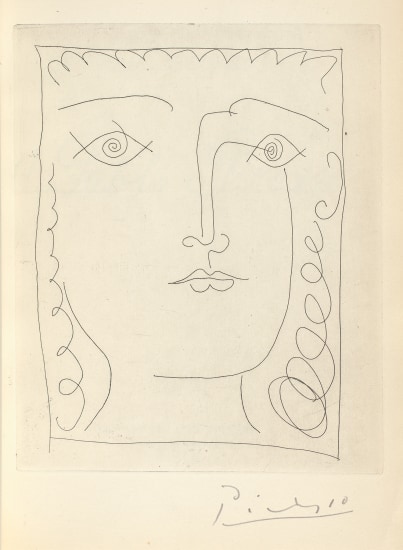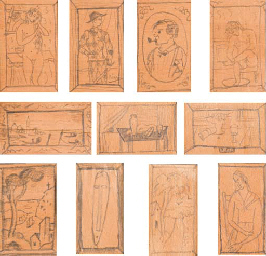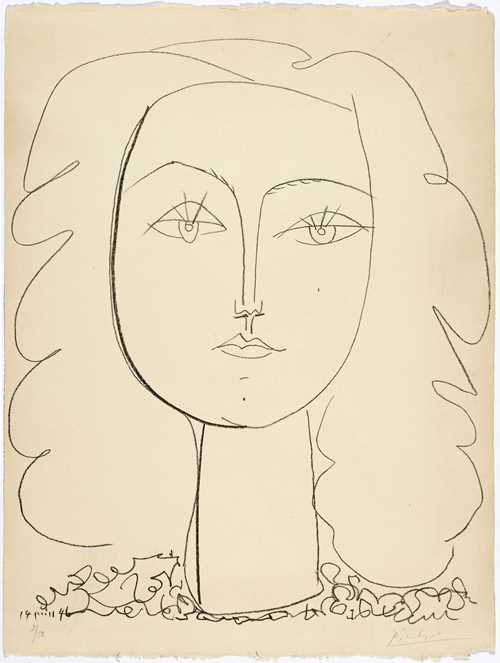The Property of a Distinguished Collector Pablo Picasso Follow Hibou hand-painted partially glazed tile 34 x 20 x 4 cm (13 3/8 x 7 7/8 x 1 5/8 in.) Executed in 1957. This work is unique and accompanied by a certificate of authenticity from Mrs Maya Widmaier-Picasso and Mr Claude Picasso.
Provenance The Estate of the artist Jaqueline Picasso, Paris (by descent from the estate) Etienne Sassi Inc., Paris Hammer Galleries, New York Private Collection, England (acquired from the above in April 2005) Christie's, South Kensington, 26 June 2014, lot 24 Acquired at the above sale by the present owner Exhibited Vallauris, Musée Magnelli, Musée de la Céramique, Picasso, Céramiste à Vallauris, Pièces uniques , July - November 2004, no. 103 (illustrated, p. 146) New York, Hammer Galleries, Picasso: Ceramics at Vallauris -1946 -1973 , April - May 2005 Catalogue Essay From 1946, Pablo Picasso completely immersed himself in the world of ceramics, avidly probing, manipulating and mastering his new malleable medium, consuming all facets and possibilities that clay presents. Arguably the most prolific artist of the 20th century, Picasso’s bombastic and relentless approach to painting, printmaking, sculpture and drawing was similarly reflected in his thirst to harness the often unpredictable nature of pottery. Executed in 1957, Hibou is a unique example of Picasso’s devotion to form, texture and mark-making, captured in the sweeping curvature of his little owl’s body and controlled application of hand-applied glaze on the verso and recto of his tile. Often exploring the representation of his key motifs, such as minotaurs, fauns and owls, across all mediums of his artistic practice, Picasso’s Hibou continues a dialogue with the ancient traditions of pottery, emerging from the kiln as a tangible realisation of Picasso’s infatuation with clay. Housed in the collection of Jacqueline Picasso, the present work was created four years after Picasso met his wife at the famed Atelier Madoura. Travelling to the Côte d'Azur in 1946, Picasso was on holiday at Golfe-Juan when on 21 July he visited an exhibition of known local artists and artisans, who were exhibiting their products and artworks in the Provençal town of Vallauris. Travelling to this small town, international craftsmen and artists had been drawn to the area due to the displacement of people during the war; Vallauris became a haven for artistic production which had a long artisanal tradition of using local clay and wood from the pine forest. Succumbed by curiosity, Picasso returned a year later to work again at the ceramic studio there, eventually establishing his ceramic practice firmly in the area. With its connection to ancient civilisation, pottery provided the ideal medium for Picasso to create ceramic pieces which would refer more holistically to the past, both in medium, form and symbolism. Surviving the test of time, ancient Greek pottery would prove to be a source of great inspiration for Picasso, invoking the swollen forms of jugs, bowls and looped handles in his modern vessels, evident in works such as Owl (Vase) (1947/1948, Musée Picasso Antibes). In the present work, Picasso depicts a hibou , a little owl, through the shaping of his tile and his use of figurative glaze decoration. As an ancient symbol of Antibes and the sacred symbol of Athena, the goddess of wisdom who concealed herself as a bird in battle, Picasso’s owls encompass connotations of intelligence and courage, as well as his fondness for the little creatures. Keeping turtle doves and pigeons at his various residences, Picasso loved animals and birds, and kept a small owl as a pet which would become a great source of inspiration in his paintings, lithographs and ceramics. As described by Françoise Gilot ‘While Pablo was still working at the Musée d’Antibes, Sima had come to us one day with a little owl he had found in a corner of the museum. One of his claws has been injured. We bandaged it and gradually it healed. We bought a cage for him and when we returned to Paris we brought him back with us and put him in the kitchen with the canaries, the pigeons, and the turtledoves. We were very nice to him but he only glared at us. Any time we went into the kitchen, the canaries chirped, the pigeons cooed and
The Property of a Distinguished Collector Pablo Picasso Follow Hibou hand-painted partially glazed tile 34 x 20 x 4 cm (13 3/8 x 7 7/8 x 1 5/8 in.) Executed in 1957. This work is unique and accompanied by a certificate of authenticity from Mrs Maya Widmaier-Picasso and Mr Claude Picasso.
Provenance The Estate of the artist Jaqueline Picasso, Paris (by descent from the estate) Etienne Sassi Inc., Paris Hammer Galleries, New York Private Collection, England (acquired from the above in April 2005) Christie's, South Kensington, 26 June 2014, lot 24 Acquired at the above sale by the present owner Exhibited Vallauris, Musée Magnelli, Musée de la Céramique, Picasso, Céramiste à Vallauris, Pièces uniques , July - November 2004, no. 103 (illustrated, p. 146) New York, Hammer Galleries, Picasso: Ceramics at Vallauris -1946 -1973 , April - May 2005 Catalogue Essay From 1946, Pablo Picasso completely immersed himself in the world of ceramics, avidly probing, manipulating and mastering his new malleable medium, consuming all facets and possibilities that clay presents. Arguably the most prolific artist of the 20th century, Picasso’s bombastic and relentless approach to painting, printmaking, sculpture and drawing was similarly reflected in his thirst to harness the often unpredictable nature of pottery. Executed in 1957, Hibou is a unique example of Picasso’s devotion to form, texture and mark-making, captured in the sweeping curvature of his little owl’s body and controlled application of hand-applied glaze on the verso and recto of his tile. Often exploring the representation of his key motifs, such as minotaurs, fauns and owls, across all mediums of his artistic practice, Picasso’s Hibou continues a dialogue with the ancient traditions of pottery, emerging from the kiln as a tangible realisation of Picasso’s infatuation with clay. Housed in the collection of Jacqueline Picasso, the present work was created four years after Picasso met his wife at the famed Atelier Madoura. Travelling to the Côte d'Azur in 1946, Picasso was on holiday at Golfe-Juan when on 21 July he visited an exhibition of known local artists and artisans, who were exhibiting their products and artworks in the Provençal town of Vallauris. Travelling to this small town, international craftsmen and artists had been drawn to the area due to the displacement of people during the war; Vallauris became a haven for artistic production which had a long artisanal tradition of using local clay and wood from the pine forest. Succumbed by curiosity, Picasso returned a year later to work again at the ceramic studio there, eventually establishing his ceramic practice firmly in the area. With its connection to ancient civilisation, pottery provided the ideal medium for Picasso to create ceramic pieces which would refer more holistically to the past, both in medium, form and symbolism. Surviving the test of time, ancient Greek pottery would prove to be a source of great inspiration for Picasso, invoking the swollen forms of jugs, bowls and looped handles in his modern vessels, evident in works such as Owl (Vase) (1947/1948, Musée Picasso Antibes). In the present work, Picasso depicts a hibou , a little owl, through the shaping of his tile and his use of figurative glaze decoration. As an ancient symbol of Antibes and the sacred symbol of Athena, the goddess of wisdom who concealed herself as a bird in battle, Picasso’s owls encompass connotations of intelligence and courage, as well as his fondness for the little creatures. Keeping turtle doves and pigeons at his various residences, Picasso loved animals and birds, and kept a small owl as a pet which would become a great source of inspiration in his paintings, lithographs and ceramics. As described by Françoise Gilot ‘While Pablo was still working at the Musée d’Antibes, Sima had come to us one day with a little owl he had found in a corner of the museum. One of his claws has been injured. We bandaged it and gradually it healed. We bought a cage for him and when we returned to Paris we brought him back with us and put him in the kitchen with the canaries, the pigeons, and the turtledoves. We were very nice to him but he only glared at us. Any time we went into the kitchen, the canaries chirped, the pigeons cooed and


.jpg?w=400)
.jpg?w=400)
.jpg)


.jpg?w=400)

.jpg)
.jpg)



.jpg?w=400)
Try LotSearch and its premium features for 7 days - without any costs!
Be notified automatically about new items in upcoming auctions.
Create an alert